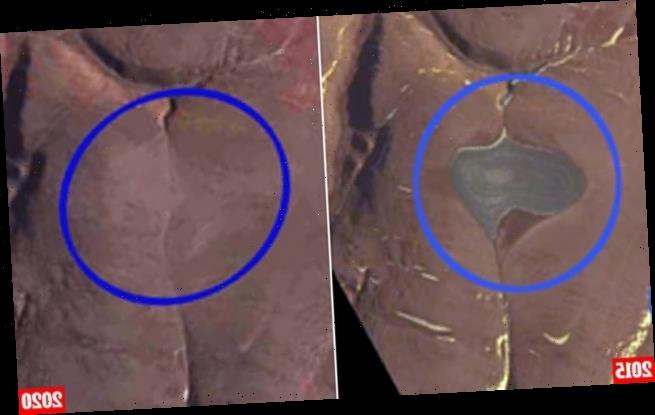Two ice caps in the Canadian Arctic have DISAPPEARED due to global warming, NASA satellite images reveal – fulfilling a bleak prediction from 2017
- The ice caps have been studied by Professor Mark Serreze since the 1980s
- Satellite images from 2015 show they were only 5% of the size they were in 1959
- Images from the satellite in 2020 show the ice caps have completely vanished
Two Arctic ice caps have vanished due to human-induced global warming, satellite images show.
Images taken by NASA in 2015 and 2020 reveal how they have disappeared in just half a decade.
Mark Serreze, director of the National Snow and Ice Data Center has studied the St. Patrick Bay ice caps in some capacity since the 1980s.
He published a scientific paper in 2017 that stated if greenhouse gas emissions are not curbed, the ice caps would vanish within five years. He was correct.
Scroll down for video
Images taken by NASA in 2015 and 2020 reveal how ttwo polar ice caps have vanished in half a decade due to global warming. Pictured, one of the caps in 2015 (left) an the same location on July 14, 2020 (right)
Pictured, the St. Patrick Bay ice caps on the Hazen Plateau of northeastern Ellesmere Island in Nunavut, Canada, and have they dwindled over the last 60 years until they have eventually disappeared
‘When I first visited those ice caps, they seemed like such a permanent fixture of the landscape,’ he said.
‘To watch them die in less than 40 years just blows me away.’
The 2017 study compared satellite imagery from 2015 with historical images dating back to 1959.
This revealed the caps were, in 2015, just five per cent of their size almost 60 years ago.
ASTER satellites took images of the same area on July 14, 2020 and the ice caps are nowhere to be found.
Most polar bear populations are at risk of dying out by 2100 as their natural habitat of Arctic sea ice is diminished by global warming, a study warns.
A damning piece of research claims the predators will be forced to migrate on to solid land, where hunting will be impossible for them.
As a result, the bears will be forced to survive on their fat reserves, an unsustainable option for the world’s largest carnivore.
The study claims that almost all polar bear cubs face some form of starvation by 2040, with many adults also experiencing reproductive stress in just 20 years’ time.
Researchers from the University of Toronto in Canada said ‘aggressive’ cuts to greenhouse gas emissions are now needed to save the animals.
The loss of these ice caps is a very visual representation of the sweltering planet humans have created and now inhabit.
Scientists regularly report hottest temperatures on record all around the world, as climate change manifests itself in a slowly boiling world.
It is leading to drought, famine and extreme weather events as well as surging sea levels.
A recent study published in Scientific Reports found coastal flooding is set to rise by around 50 per cent globally due to climate change in the next 80 years.
UK and Australian researchers conducted climate change scenarios where carbon dioxide concentrations in the atmosphere continue to rise rapidly.
They found the associated flooding, due to the melting of polar ice, would endanger millions of people and cost more than £10 trillion.
Land exposed to extreme flooding will increase by more than 96,500 square miles globally – up 48 per cent or more than 308,000 square miles from today.
This would mean about 77 million more people will be at risk of experiencing flooding – a rise of 52 per cent to 225 million at the very least.
‘We’ve long known that as climate change takes hold, the effects would be especially pronounced in the Arctic,’ Professor Serreze says.
‘But the death of those two little caps that I once knew so well has made climate change very personal. All that’s left are some photographs and a lot of memories.’
Source: Read Full Article


